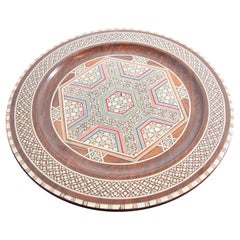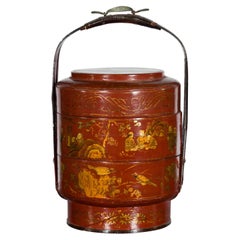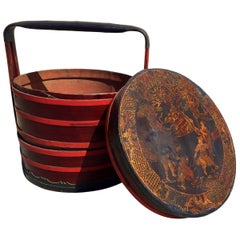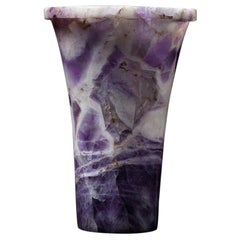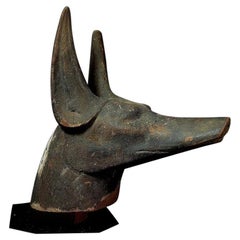Egyptian More Asian Art, Objects and Furniture
to
1
1
1
1
1
628
1,730
800
679
549
1
1
1
Place of Origin: Egyptian
Middle Eastern Egyptian Inlaid Marquetry Decorative Platter
Located in North Hollywood, CA
Middle Eastern Moorish decorative plate inlaid with mosaic marquetry.
This beautiful wooden plate with elaborate mosaic marquetry inlay is from Cairo, Eg...
Category
Mid-20th Century Moorish Egyptian More Asian Art, Objects and Furniture
Materials
Wood
Related Items
Early 20th Century Three-Tiered Red Lacquer Lunch Basket with Gilt Décor
Located in Yonkers, NY
A Chinese three-tiered lunch basket from the early 20th century with red lacquer, gilded décor and black bamboo handle. Created in China during the early years of the 20th century, this three-tiered lunch basket features a red lacquered ground accented by a lovely gilded hand-painted décor. Topped with a large black lacquered tripartite bamboo handle with rattan links and metal detail, the basket is topped with a circular lid adorned with a grouping or women and children sitting or standing in front of a bench. The body itself showcases children with ribbon-tied pigtails sitting down, carrying lamps or crossing a bridge among others, while the lower section is decorated with birds perched on branches or rocks. Each section is removable and presents a dark brown with purple undertone interior. With its small proportions, complimenting colors and skillfully painted décor, this early 20th century Chinese three-tiered basket...
Category
Early 20th Century Egyptian More Asian Art, Objects and Furniture
Materials
Metal
Chinese Antique Bamboo Basket with Painted Lid
Located in Somis, CA
Beautiful two-tier basket features painted, gilded images of an opera scene showing a victorious battle. Basket is lacquered in cinnabar, a special mix of ...
Category
19th Century Antique Egyptian More Asian Art, Objects and Furniture
Materials
Bamboo, Wood
Andrianna Shamaris Organic Teak Wood Vessel
By Andrianna Shamaris
Located in New York, NY
This organic teak vessel serves as a stunning sculptural piece and a practical solution to hold fruit, magazines, towels, etc. We left the sides raw in contrast. Organic is the new m...
Category
2010s Organic Modern Egyptian More Asian Art, Objects and Furniture
Materials
Wood, Teak, Reclaimed Wood
Antique Rattan Tiered Wedding Basket with Carved Handle and Red Top
Located in Yonkers, NY
A Chinese antique rattan two-tiered wedding basket from the early 20th century, with carved handle and red top. Born in China during the early years of the 20th century, this charming wedding basket features a circular red lid, sitting above two independent rattan-covered sections. Presenting a lovely lacquered interior and an ebonized base, the basket showcases a large handle, delicately carved on the sides. Used as a decorative accent or to store and organize items, this Chinese antique wedding basket...
Category
Early 20th Century Egyptian More Asian Art, Objects and Furniture
Materials
Rattan, Wood
Japanese Ikebana 'Flower Arranging Basket' by Teijo Sai
Located in Hudson, NY
Japanese Ikebana (Flower Arranging Basket), Signed by Teijo Sai (the artist) on the bottom.
Meiji Period (1868-1912) ikebana made of smoked bamboo, polished with ash. Very nice weav...
Category
Early 1900s Meiji Antique Egyptian More Asian Art, Objects and Furniture
Materials
Bamboo
Antique Lacquered Gift Delivering Basket with Hand Painted Floral Décor
Located in Yonkers, NY
A Chinese late Qing Dynasty period antique lacquered octagonal basket from the early 20th century with hand painted floral décor, large handle and made to deliver gifts. Created in C...
Category
Early 20th Century Qing Egyptian More Asian Art, Objects and Furniture
Materials
Brass
Antique 19th Century Wood and Metal Grain Basket with Carrying Handle
Located in Yonkers, NY
A rustic Chinese Qing Dynasty period wooden grain basket from the 19th century, with large carrying handle and metal braces. Created in China during the Qing Dynasty period in the 19...
Category
19th Century Qing Antique Egyptian More Asian Art, Objects and Furniture
Materials
Metal
$740
H 21.5 in W 15 in D 13.5 in
Far Eastern Early 20th Century Shoulder Yoke with Bamboo and Rattan Baskets
Located in Atlanta, GA
A Far Eastern shoulder yoke from the early 20th century, with rattan and bamboo baskets. Charming us with its history and nicely weathered appearance, this Far Eastern shoulder yoke ...
Category
Early 20th Century Rustic Egyptian More Asian Art, Objects and Furniture
Materials
Bamboo, Rattan, Wood
$795
H 10.5 in W 66.75 in D 19.25 in
Antique Jujube Wine Barrel
Located in Somis, CA
A heavy, solid jujube wood wine barrel from Northern China. Solid wood construction with original, thick, wide, hand-forged iron bands. Substantial hand crafted handle. A wonderful c...
Category
19th Century Antique Egyptian More Asian Art, Objects and Furniture
Materials
Iron
Elm Bowl by Vlad Droz
Located in Geneve, CH
Elm bowl by Vlad Droz.
Dimensions: D 35 x H 30 cm.
Materials: Elm.
One of a kind.
Elm Bowl by Russian Vlad Droz. This bowl is greenturned, charred, sandblasted and dyed.
Vlad Droz...
Category
2010s Post-Modern Egyptian More Asian Art, Objects and Furniture
Materials
Elm
Chinese Rice Measure Basket with Engraved Iron Fittings, Early 20th Century
Located in Jimbaran, Bali
A rice measure container handcrafted more than 100 years from wood and supported by engraved iron edges and an arched handle. There is a wonderful age related patina to the metal and...
Category
Early 20th Century Other Egyptian More Asian Art, Objects and Furniture
Materials
Iron
$375
H 10.24 in W 13 in D 13 in
Andrianna Shamaris Impressive Charred Teak Wood Vessel
By Andrianna Shamaris
Located in New York, NY
Impressive long charred vessel hand carved from a single piece of reclaimed teak. Burnt sanded and sealed revealing the beautiful wood grain.
The Triple Burnt Collection represents ...
Category
2010s Organic Modern Egyptian More Asian Art, Objects and Furniture
Materials
Wood, Teak, Reclaimed Wood
Previously Available Items
Ancient Egyptian Purple Amethystine Quartz Ointment Vase
Located in London, GB
From the Old Kingdom onwards, many descriptive wall reliefs and paintings can be found depicting the production of various stone vessels . We can infer from these portrayals that the...
Category
15th Century and Earlier Antique Egyptian More Asian Art, Objects and Furniture
Materials
Stone
Head of Anubis
Located in London, GB
Anubis the God of Death is among the most iconic gods in ancient Egypt and people during this time knew him as Anpu or Inpu. Anubis is among the oldest deities whose mentioning can b...
Category
15th Century and Earlier Antique Egyptian More Asian Art, Objects and Furniture
Materials
Wood
Large Faience Ram
Located in London, GB
Strikingly similar to the Romano-Egyptian Ram currently in the Met this piece depicts a ram, with a highly textured and naturalistically modelled coat, curled horns and a static forw...
Category
15th Century and Earlier Antique Egyptian More Asian Art, Objects and Furniture
Materials
Ceramic
The 'Gillot' Taweret
Located in London, GB
This statuette represents the goddess Taweret, an apotropaic goddess, whose domain was the protection of pregnant women and their babies, especially during childbirth. Her threatenin...
Category
15th Century and Earlier Antique Egyptian More Asian Art, Objects and Furniture
Materials
Limestone
Ushabti of 'Paser'
Located in London, GB
An Ushabti is a funerary figurine used throughout ancient Egypt, placed in a tomb to aid as a servant to the deceased, conducting manual labour for them...
Category
15th Century and Earlier Antique Egyptian More Asian Art, Objects and Furniture
Materials
Limestone
Ushabti of 'Kenj'
Located in London, GB
The XIX Dynasty of Ancient Egypt was part of the Egyptian New Kingdom and was founded by Vizier Ramasses I, whom Pharaoh Horemheb chose as his successor to the throne. The XIX Dynasty is best remembered for its military conquests in the lands of Canaan. The relative peace of the XVIII Dynasty gave way to a century of wars, which produced art that attempted to maintain ancestral traditions in order to claim its dynastic lineage and succession to the throne.This large serpentine statue tells of the prominence of administrative art during this period. The figure is an ushabti, a funerary statue that would have been placed in a tomb among the grave goods of the inhabitant, intended to act as a servant for the deceased in the afterlife. The ushabtis would be called upon to perform their menial tasks, each figure's purpose is often attested to by objects in their hands, such as bread-baker holding grain or farmer holding a scythe, and they would be donated by the workers of the deceased to fulfill their roles for them in death. Hieroglyphics could often also be found running the length of their legs giving further clues to their roles and stating whom they intended to work for. These inscriptions were called answers and asserted the figures readiness to be summoned to the gods work The practice of placing ushabtis inside tombs originated in the Old Kingdom, with the earliest evidence from the middle of the third millennium B.C. when they buried next to mummies[2]. They are normally miniature in size, of hard stones such as limestone, granite or serpentine (and occasionally of faience or bronze), and produced in multiples to provide the important deceased with an army of workers. Sometimes so many were produced that they world cover the entire surface floor of a tomb. Due to this commonness, many extant examples survive, in varying qualities, and as a collection of artifacts they provide a unique insight in to the fascinating death customs of the Ancient Egyptians, highlighting their very real belief in an eternal afterlife.This beautifully carved statue holds hoes and a seed sack, indicating they were destined for manual toil in the eternal afterlife amongst the fields growing grain to produce food for the interred. Another agricultural implement with crisscrossing ropes is tucked in to the back of the figure's kilt, making sure he is ready for any farming situation necessary. He wears a long-sleeved shirt with a long pleated kilt, which has a large over-fold and broad beaded collar. He also wears a double wig composed of zig-zags and echeloned curls, and his face has a slightly aquiline nose, with almond-shaped eyes a fixed, determined gaze.A column running the length of his over-fold contains five lines of hieroglyphic inscription that name the owner of the worker (Kenj), and recite chapter VI from the Ancient Egyptian Book of...
Category
15th Century and Earlier Antique Egyptian More Asian Art, Objects and Furniture
Materials
Granite
Cosmetic Duck Vessel
Located in London, GB
This vessel, carved in the form of a wild duck, would have served the purpose of a cosmetic vessel or 'toilet spoon'. Comprised of three individual sections, the head is attached to the base with a collar of bone, and the movable lid is secured by a bone pin...
Category
15th Century and Earlier Antique Egyptian More Asian Art, Objects and Furniture
Materials
Wood
Exceptional Pair of Islamic Middle Eastern Ceramic Tiles with Quran Verses
Located in Queens, NY
An exceptional and large pair of Islamic Middle Eastern ceramic tiles with Quran verses,
20th century.
Each set with 35 ceramic tiles, measuring 6? x 6...
Category
20th Century Islamic Egyptian More Asian Art, Objects and Furniture
Materials
Ceramic
Mother-of-pearl Inlaid Dome Jewelry Box
Located in Somis, CA
A stunning handmade jewelry box. The craftsmanship on this beautiful piece is amazing. The wood box is entirely encrusted in genuine mother-of-pea...
Category
2010s Egyptian More Asian Art, Objects and Furniture
Materials
Felt, Wood, Mother-of-Pearl
Egyptian Brass Inkwell Qalamdan
Located in North Hollywood, CA
A 19th century brass decorated Islamic Qalamdan.
The Qalamdan is in solid brass, decorated on all sides with Egyptian scenes.
It consists of an inkwell and a pen compartment of typic...
Category
19th Century Moorish Antique Egyptian More Asian Art, Objects and Furniture
Materials
Brass
